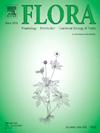从伊朗高原进入欧亚草原带的中心:芸苔属植物的系统地理学
IF 1.7
4区 生物学
Q3 ECOLOGY
引用次数: 0
摘要
欧亚草原带是世界上最大的草原地区。该草原带的植物区系在不同地区之间存在很大差异,其各个要素的时空进化史也不尽相同。本研究的主要目的是调查一种重要草原植物的系统地理格局。我们采用多焦点方法对从野外和标本馆调查中收集到的 136 份 Sisymbrium polymorphum 进行了基因鉴定。我们对所得到的系统发生树进行了年代测定,并采用根式 TCS 网络方法来估计单个遗传标记的进化历史。大多数单倍体和核型的地理分布受到限制。据估计,S. polymorphum 的茎干年龄在上新世早期,而树冠年龄在上新世晚期。我们推测,这种植物是通过多次迁徙,经由都兰低地的科佩特达赫山脉引入欧亚草原带的。迁徙路线的时间范围受到上新世末帕拉泰西退缩和更新世初里海阿克恰吉勒横断的限制。没有发现其他证据表明发生了进一步的迁移事件。阿克恰吉勒大断裂在两个方面起到了物理地理屏障的作用。首先,它限制了从伊朗高原向欧亚大草原移民的时间窗口;其次,它暂时阻断了欧亚大草原西部和东部之间的草原内迁徙路线。本文章由计算机程序翻译,如有差异,请以英文原文为准。
From the Iranian Plateau into the heart of the Eurasian steppe belt: The phylogeography of Sisymbrium polymorphum (Brassicaceae)
The Eurasian steppe belt is the largest grassland region in the world. The flora of this belt varies greatly between its regions, and its individual elements have different spatiotemporal evolutionary histories. The main aim of this study was to investigate the phylogeographic pattern of a prominent plant steppe element. We genetically characterized 136 accessions of Sisymbrium polymorphum collected from field and herbarium surveys using a multi-locus approach. We dated the resulting phylogenetic trees and employed rooted TCS network methods to estimate the evolutionary history of individual genetic markers. The majority of haplo- and ribotypes showed restricted geographic distributions. Stem age of S. polymorphum was estimated to be in the early Pliocene, while its crown age was estimated to be in the late Pliocene. We hypothesize that this plant was introduced to the Eurasian steppe belt through the Kopet Dagh mountain chain over the Turanian lowlands via multiple migration events. Time frame along the migration route was limited by the retreat of the Paratethys at the end of the Pliocene and the Akchagyl transgression of the Caspian Sea at the beginning of the Pleistocene. No additional evidence was found to suggest any further migration events occurred. The Akchagyl transgression acted as a physiogeographical barrier in two ways. Firstly, it restricted the time window for immigration from the Iranian Plateau into the Eurasian steppe, and secondly, it temporarily blocked intra-steppe migration routes between the western and eastern parts of the Eurasian steppe.
求助全文
通过发布文献求助,成功后即可免费获取论文全文。
去求助
来源期刊

Flora
生物-植物科学
CiteScore
3.30
自引率
10.50%
发文量
130
审稿时长
54 days
期刊介绍:
FLORA publishes original contributions and review articles on plant structure (morphology and anatomy), plant distribution (incl. phylogeography) and plant functional ecology (ecophysiology, population ecology and population genetics, organismic interactions, community ecology, ecosystem ecology). Manuscripts (both original and review articles) on a single topic can be compiled in Special Issues, for which suggestions are welcome.
FLORA, the scientific botanical journal with the longest uninterrupted publication sequence (since 1818), considers manuscripts in the above areas which appeal a broad scientific and international readership. Manuscripts focused on floristics and vegetation science will only be considered if they exceed the pure descriptive approach and have relevance for interpreting plant morphology, distribution or ecology. Manuscripts whose content is restricted to purely systematic and nomenclature matters, to geobotanical aspects of only local interest, to pure applications in agri-, horti- or silviculture and pharmacology, and experimental studies dealing exclusively with investigations at the cellular and subcellular level will not be accepted. Manuscripts dealing with comparative and evolutionary aspects of morphology, anatomy and development are welcome.
 求助内容:
求助内容: 应助结果提醒方式:
应助结果提醒方式:


